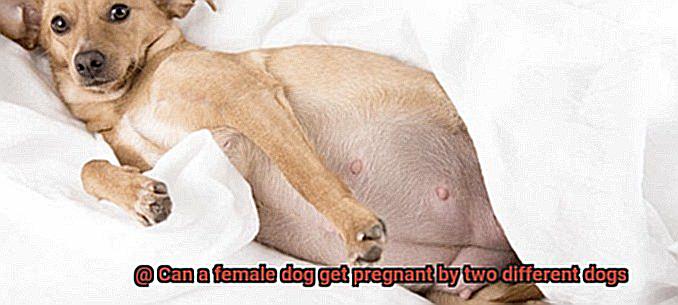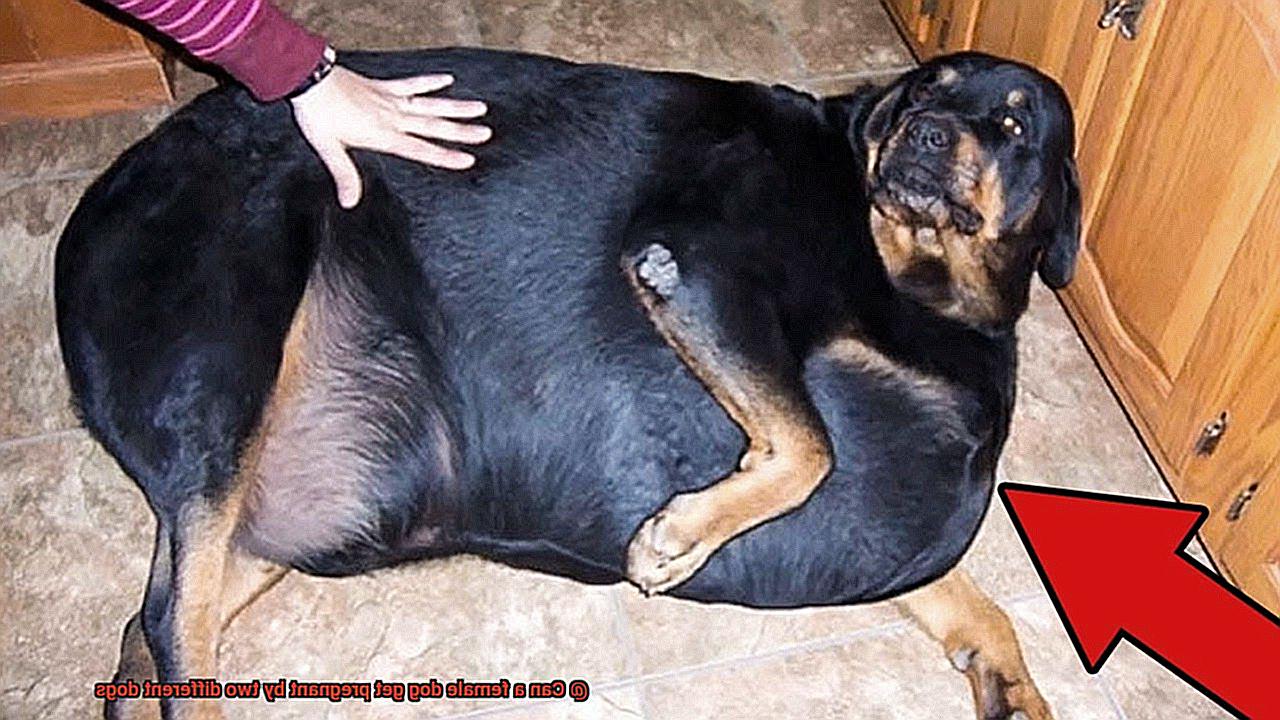Can a female dog get pregnant by two different dogs?
Prepare to be amazed, my fellow dog lovers. We’re about to embark on a wild adventure into the world of canine reproduction. Picture this: a female dog, caught in the middle of an unexpected love triangle with not one, but two potential baby daddies. Can it really happen? Can a female dog get pregnant by two different dogs?
Nature has a way of throwing curveballs, and when it comes to the birds and the bees (or should I say, the dogs and the puppies), things can get downright intriguing. So buckle up and hold on tight as we dive deep into the mysteries of dual fatherhood in our furry friends.
We’ll unravel the secrets behind canine reproduction, exploring mind-boggling concepts like superfecundation – where multiple eggs are fertilized by different sperm – and those rare moments when Mother Nature decides to break all the rules.
Get ready for a rollercoaster ride through the fascinating realm of canine genetics. We’ll uncover whether our beloved four-legged companions can indeed become impregnated by two different male dogs simultaneously. It’s time to separate fact from fiction and discover just how wild nature can truly be.
So grab your popcorn (or should I say puppy chow?) and join us on this thrilling journey. Let’s find out if our furry friends are capable of creating their very own soap opera-esque love stories. Trust me, you won’t want to miss this paw-some tale.
How Does a Female Dog Become Pregnant by Two Different Dogs?
Contents
- 1 How Does a Female Dog Become Pregnant by Two Different Dogs?
- 2 The Heat Cycle and Fertilization Process in Dogs
- 3 Understanding Mixed Paternity Litters in Dogs
- 4 The Risks of Multiple Sires in a Litter
- 5 DNA Testing to Determine Parentage of Puppies
- 6 Tips for Dog Owners to Prevent Unwanted Breeding Situations
- 7 Proper Care for Female Dogs During Pregnancy with Multiple Sires
- 8 Socializing Puppies from Mixed-Sire Litters
- 9 Conclusion
If you’re a proud owner of a French bulldog, or any other breed for that matter, you may have wondered if it’s possible for your female dog to become pregnant by two different dogs. It sounds like something out of a soap opera, but in reality, it’s not as uncommon as you might think. In this blog post, we’ll delve into the fascinating world of canine reproduction to understand how this phenomenon, known as superfecundation, occurs.
Understanding Canine Reproduction:
To comprehend how a female dog can have puppies from different fathers, let’s first familiarize ourselves with the basics of canine reproduction. Like many mammals, dogs have an estrous cycle consisting of four stages: proestrus, estrus, diestrus, and anestrus. It is during the estrus stage that the female is receptive to mating and can conceive.
Superfecundation: The Secret Ingredient:
Now that we know when the magic happens let’s dive into the concept of superfecundation. Superfecundation occurs when a female dog mates with multiple male dogs during her heat period and releases multiple eggs that are fertilized by different sperm. Unlike humans who typically release one egg per menstrual cycle, dogs release multiple eggs, increasing the chances of superfecundation.
Timing is Everything:

Timing plays a crucial role in determining whether superfecundation will occur. The female dog must mate with different males within a short period while she is still fertile and releasing viable eggs. Multiple matings increase the likelihood of sperm from different males being present in the reproductive tract when ovulation occurs.
The Miracle of Mixed Paternity Litters:
Once fertilization occurs, the embryos travel through the fallopian tubes and implant themselves into the uterus walls. Each embryo develops separately, resulting in a litter of puppies sired by different fathers. These unique litters are known as mixed paternity litters and are a testament to the fascinating reproductive biology of dogs.
The Heat Cycle and Fertilization Process in Dogs
Are you curious about the heat cycle and fertilization process in French Bulldogs? Well, buckle up and get ready for an exciting journey into the world of canine reproduction. In this comprehensive guide, we’ll cover everything from the stages of the heat cycle to the intricacies of fertilization. So let’s dive right in.
Stage 1: Proestrus – The Prelude to Romance
This is the stage where things start heating up. During proestrus, your French Bulldog’s vulva becomes swollen and she may leave little love notes in the form of blood spots. She might also display flirtatious behaviors such as increased urination and attracting male suitors with her irresistible scent.
Stage 2: Estrus – The Dance of Passion
Now it’s time for the main event – estrus. This is when your Frenchie is at her most fertile and ready to mingle. She’ll allow mating and might even go on a quest to find her perfect match. So keep an eye out for any potential Romeo’s lurking around your neighborhood.
Stage 3: Diestrus – The Afterglow
After a passionate encounter, your Frenchie enters diestrus. This is a cool-down period where fertility decreases, and your pup can finally catch her breath. It’s important to give her plenty of rest during this stage as her body prepares for the next chapter.
Stage 4: Anestrus – Time for a Paws
Anestrus is like a vacation for your Frenchie’s reproductive system. It’s a well-deserved break where everything returns to normal, and your pup can enjoy some peace and quiet. So go ahead, cuddle up with your furry friend and take a break from all the romance.
Fertilization – Cupid’s Magic
Now, let’s talk about how the magic happens – fertilization. During mating, the male dog’s sperm makes its way into the female’s vaginal canal. From there, it embarks on an epic journey through the cervix and into the uterus. If any eggs were released during ovulation, these brave little swimmers can fertilize them and create adorable little French Bulldog puppies.
Did you know that female dogs can release multiple eggs during their heat cycle? That means if your Frenchie decides to have a wild party with multiple suitors, each egg can potentially be fertilized by a different sperm. It’s like a canine version of The Bachelor.
However, don’t fret too much about this possibility. The timing of ovulation and the survival of sperm play crucial roles in determining whether fertilization will occur. Plus, Mother Nature has her own tricks up her sleeve to prevent multiple pregnancies, such as sperm competition and selective fertilization.
Understanding Mixed Paternity Litters in Dogs
In this blog post, we will delve into the concept of mixed paternity litters in dogs and explore its implications for responsible breeding. So, grab a cup of coffee and get ready to embark on an exhilarating journey into the genetic wonders of French Bulldogs.
Understanding Mixed Paternity Litters:
Mixed paternity litters occur when a female dog mates with multiple male dogs during her heat cycle. This phenomenon is more common in free-roaming or uncontrolled breeding situations, where multiple males have access to a female in heat. It can also happen in cases of artificial insemination using semen from different males.
The Genetic Marvels:
Mixed paternity litters result in puppies with different fathers, each contributing their own set of genetic characteristics. Just like siblings who resemble different parents, these puppies can exhibit diverse traits such as coat color, body structure, and temperament. It’s like having a litter full of unique individuals who embody the best qualities of their respective dads.
Determining Paternity:
While it may be exciting to have a litter with mixed paternity, it can pose challenges for breeders or owners who desire to accurately determine the lineage or potential health issues associated with each puppy.
Thankfully, DNA testing has emerged as the most reliable method to identify the sire(s) of each puppy in a mixed paternity litter. This ensures that accurate records are maintained and helps breeders make informed decisions regarding future breeding practices.
Responsible Breeding Considerations:
As much as mixed paternity litters can be intriguing from a genetic standpoint, it is vital to consider the implications for responsible breeding. Breeders and owners must prioritize the health and welfare of the puppies involved.
Genetic testing helps identify potential health risks associated with specific bloodlines, enabling breeders to make informed decisions to improve the breed’s overall health.
Conclusion:
Understanding mixed paternity litters in dogs, especially in French Bulldogs, provides invaluable insights into the complexities of reproduction and genetics. By embracing the marvels of mixed paternity litters and utilizing DNA testing, responsible breeders can navigate these complexities more effectively and ensure the production of healthy, well-bred French Bulldog puppies.
The Risks of Multiple Sires in a Litter
While this may sound intriguing, it’s important to understand the risks associated with multiple sires in a litter. As an expert in the field, I’m here to shed light on these risks and provide valuable insights for French Bulldog owners.
Determining Paternity:
One of the major challenges of multiple sires in a litter is determining the paternity of each puppy. Without DNA testing, it can be like trying to solve a puzzle without all the pieces. DNA testing is essential for accurate tracking of lineage and pedigree, which is crucial for responsible breeding practices.
Genetic Diversity:
Having multiple sires can result in greater genetic diversity within a litter. While this can be beneficial for overall health and vigor, it can also lead to a wider range of physical traits and characteristics. So, if you were hoping for a litter of look-alike puppies, you may be in for a surprise.
Health Risks:
Another risk to consider is the potential for genetic disorders or health issues. If one of the males carries a genetic mutation or is prone to a specific disease, there is a higher chance that some puppies may inherit these traits. Responsible breeders must carefully select mating partners free of known genetic issues to reduce these risks.
Responsible Breeding Practices:
Managing multiple sires in a litter requires diligent record-keeping and transparency from breeders. It’s crucial to provide potential buyers with accurate information about the possibility of multiple fathers and conduct DNA testing if necessary. This ensures responsible breeding practices and helps maintain the integrity of the breed.
Owner Perspective:
As an owner, the presence of multiple sires in a litter may not have significant implications unless you are interested in breeding or showing your dog. However, it’s still important to be aware of the possibility and understand the potential variations in physical traits and health issues among the puppies.
DNA Testing to Determine Parentage of Puppies
These lovable and unique creatures capture our hearts with their adorable features and playful personalities. However, when it comes to determining the parentage of puppies, things can get a little complicated. That’s where DNA testing comes in. As an expert in the field, I’m here to guide you through this fascinating process and shed light on its importance for responsible breeders and owners.
The Process:
DNA testing is a reliable method that helps breeders accurately determine the parentage of French Bulldog puppies. To begin, DNA samples are collected from the mother, potential fathers, and the puppies themselves. This can be done easily through simple cheek swabs or blood samples. These samples are then sent to a reputable laboratory where they undergo thorough analysis.
The Analysis:
In the laboratory, genetic markers from the samples are compared to determine if there is a match between the mother, potential fathers, and the puppies. The analysis is highly accurate and can identify the biological father of each puppy with a high degree of certainty. This information is crucial for breeders who aim to establish accurate pedigrees and lineage records for their puppies.
Benefits of DNA Testing:
DNA testing not only helps establish accurate pedigrees but also aids in cases where there is a dispute over parentage or when determining the genetic health risks of the puppies. It allows breeders to make informed decisions about which dogs to include in their breeding programs, ensuring healthier and happier puppies.
Choosing a Reliable Laboratory:
To ensure accurate results, it is important to choose a reputable and reliable laboratory for DNA testing. Look for laboratories that have experience in canine DNA testing and have positive reviews from other breeders or owners who have used their services.
Tips for Dog Owners to Prevent Unwanted Breeding Situations
Unplanned pregnancies can lead to various challenges and risks for both the mother and the puppies. By following these tips, you can ensure the well-being of your pet and prevent any unintended matings.
Spaying or Neutering:
Spaying or neutering your dog is one of the most effective ways to prevent unwanted breeding. These procedures eliminate the possibility of a female dog getting pregnant or a male dog impregnating other dogs. Spaying involves removing the ovaries and uterus of a female dog, while neutering involves removing the testicles of a male dog.
Supervision and Control:
During a female dog’s heat cycle, she becomes fertile and attracts male dogs. To prevent unplanned encounters, closely supervise your dog, especially when she is in heat. Keep her securely leashed or fenced to avoid any accidental mating.
Secure Fencing and Enclosures:
Ensure that your property has secure fencing and enclosures to prevent female dogs from escaping in search of a mate. Female dogs in heat can be determined to find a mate, so strong barriers are necessary to keep them safe and prevent mating with unknown dogs.
Socialization and Training:
Proper socialization and training play a crucial role in preventing unwanted breeding situations. Train your dog to respond to commands and obey your instructions, which can effectively prevent sexual behaviors with other dogs. Socialization also helps keep your dog calm around other canines.
Identification and Microchipping:
Ensure that your female dog has proper identification, such as a collar with tags or a microchip. In case she escapes or gets lost during her heat cycle, this identification will help quickly identify her and contact you to prevent any unwanted breeding situations.
Communication with Other Dog Owners:
Communicate with other dog owners in your community, especially those who have intact male dogs. Inform them about your female dog’s heat cycle and ensure that their male dogs are kept away during that time to prevent accidental matings.
Proper Care for Female Dogs During Pregnancy with Multiple Sires
If you’re a proud owner of a French Bulldog and your furry friend is expecting a litter, it’s important to be aware of the possibility of multiple sires. This situation, known as superfecundation, occurs when a female dog mates with more than one male during her heat cycle. Don’t worry though, with the right care and attention, you can ensure the well-being of both the mother and the puppies. Let’s dive into the proper care needed during this exciting time.
Determining the Number of Potential Fathers
The first step in caring for a pregnant dog with multiple sires is to determine the number of potential fathers. You can do this through genetic testing or by observing the physical characteristics of the puppies after birth. This information can be helpful for future health monitoring and potential breed-specific considerations.
Providing Proper Nutrition
Proper nutrition is crucial during pregnancy. Pregnant dogs require a balanced diet that is rich in nutrients like protein, vitamins, and minerals. Consultation with a veterinarian can help determine the appropriate diet for your French Bulldog’s specific needs.
Regular Veterinary Check-ups
Regular veterinary check-ups are vital during pregnancy to monitor the health and progress of your French Bulldog. Ultrasounds can confirm pregnancy and evaluate puppy development. Your vet can also provide guidance on vaccinations and preventive treatments.
Exercise in Moderation
While exercise is important, pregnant dogs should engage in moderate physical activity to maintain muscle tone and overall health. Avoid strenuous activities that could put stress on their bodies or risk injury.
Adequate Rest and Relaxation
Ensure your pregnant French Bulldog has a quiet and comfortable space to rest undisturbed. This reduces stress and promotes healthy development for both the mother and puppies.
Limited Socialization
Limit socialization with other dogs during pregnancy to avoid conflicts or unnecessary stress. Keep pregnant dogs away from intact males to prevent further mating and potential complications.
Additional Support and Care
During the later stages of pregnancy, prepare a suitable whelping area where the mother can give birth and nurse her puppies comfortably. Consult with a veterinarian or professional breeder experienced with multiple-sire litters for guidance and support throughout the pregnancy.
Socializing Puppies from Mixed-Sire Litters
As a proud owner of French Bulldogs, you may find yourself facing the unique situation of having puppies from mixed-sire litters. This occurs when a female dog mates with multiple males during her heat cycle, resulting in a litter of puppies that share different fathers.
While this may be an unexpected twist in your furry family’s tale, it is important to understand the significance of socializing these puppies from an early age. In this section, we will delve into why socialization is crucial and provide you with some paw-some tips to give your little ones the best start in life.
Early Socialization: Building Pawsitive Foundations
Just like building a solid foundation for a French bulldog’s iconic bat ears, early socialization sets the stage for a lifetime of confident and well-adjusted behavior. From the moment those adorable puppies enter the world, it’s essential to introduce them to various sights, sounds, smells, and experiences. This helps them develop positive associations and build their pawsome confidence.
Handling and Touch: A Touch of Love
Gentle handling and touch are like belly rubs for the soul. Regularly cradling those cute French Bulldog puppies in your arms helps them become comfortable with human touch and builds a strong bond between you and your furry companions. So go ahead, shower them with cuddles and gentle caresses – their hearts (and tails) will thank you.
Littermate Interaction: Roughhousing for Ruff-tastic Skills
There’s nothing quite like a good old-fashioned puppy playtime. Allowing those mixed-sire litter puppies to interact freely with their littermates is like sending them to puppy school. Through playful roughhousing, they learn valuable skills such as bite inhibition and body language communication. Plus, it’s just plain fun to watch those little rascals tumble and wrestle.
Exposure to Different People: Social Butterflies in the Making
French Bulldogs are known for their friendly and social nature, and proper socialization helps foster this paw-some trait. Introduce your puppies to a diverse range of people – young, old, tall, short, and everything in between. This exposure helps them become comfortable around different types of humans, ensuring they grow up to be social butterflies rather than shrinking violets.
Exposure to Other Animals: Woof-tastic Friends from All Walks of Life
Variety is the spice of life, and it applies to furry friends too. Introduce your puppies to friendly and well-behaved dogs to help them learn appropriate canine communication skills. And why stop at dogs? Consider controlled introductions to other species like cats or small animals. This broadens their understanding of different animals and reduces potential fear or aggression towards them.
rSXS1h_m8lI” >
Conclusion
Yes, a female dog can indeed get pregnant by two different dogs.
It’s a phenomenon known as superfecundation, and it occurs when a female dog mates with multiple males during her fertile period. This can result in puppies from different fathers within the same litter.
So, if you have ever wondered whether it’s possible for a female dog to have puppies with different dads, the answer is a resounding yes.




